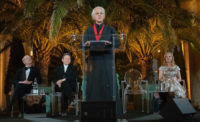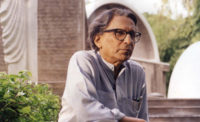2019 Pritzker Architecture Prize Goes to Arata Isozaki

Palau D’Esports Sant Jordi, Barcelona (1983-90)
Main sports hall for the 1992 Olympic Games
Photo © Hisao Suzuki

The Museum of Contemporary Art, Los Angeles (1981-86)
Photo © Yasuhiro Ishimoto

Ōita Prefectural Library, Ōita, Japan (1962-66)
Photo © Yasuhiro Ishimoto

Kitakyushu Central Library, Fukuoka, Japan (1973-74)
Photo © Yasuhiro Ishimoto

Domus: La Casa del Hombre, La Coruña, Spain (1993-95)
Photo © Hisao Suzuki

Nara Centennial Hall, Nara, Japan (1992-98)
Photo © Hisao Suzuki

Qatar National Convention Center, Doha, Qatar (2004-2011)
Photo © Hisao Suzuki

Shanghai Symphony Hall, Shanghai (2008-2014)
Photo © Chen Hao








For Arata Isozaki, winner of the 2019 Pritzker Prize, inspiration for shaping the physical starts with the intangible. “The most interesting thing in architecture to me is receiving something invisible by the senses,” says the Japanese architect. “As art, and as urban design, I always looked for new ideas to assemble.”
Isozaki’s six-decade (and counting) career has been characterized by work that promotes dialogue between East and West—“not through mimicry or as a collage, but through the forging of new paths,” notes the Pritzker Jury in its citation.

Born in 1931 in Ōita, on the Island of Kyushu, Isozaki was 12 years old when the United States bombed Hiroshima, just across the water from where he lived. “When I was old enough to begin an understanding of the world, my hometown was burned down,” he said. “I grew up on ground zero. It was in complete ruins, and there was no architecture, no buildings and not even a city. Only barracks and shelters surrounded me. So, my first experience of architecture was the void of architecture, and I began to consider how people might rebuild their homes and cities.” This preoccupation with new concepts of urbanism continues to permeate the architect’s work. (Watch the video below for an explanation of his ongoing project, The Experimental City “X.”)
Isozaki studied architecture at the University of Tokyo, graduating in 1954, and went on to apprentice under Kenzo Tange, the 1987 Pritzker laureate. He traveled the world extensively as a young man—“at least ten times before I turned 30. I wanted to feel the life of people in different places,” he said. “Through this, I kept questioning, ‘What is architecture?’”
In 1963, the architect established his firm, Arata Isozaki & Associates, after the Allied occupation of Japan ended and the country was beginning to rebuild. In his hometown, he designed the Ōita Medical Hall (1959-60) and Annex (1970-1972), as well as the Ōita Prefectural Library (1962-1966, renamed Ōita Art Plaza in 1996). Elsewhere in Japan, his significant projects include Expo ’70 Festival Plaza (1966-1970, Osaka), the Museum of Modern Art, Gunma (1971-1974), and Kitakyushu Municipal Museum of Art (1972-1974, Fukuoka).

Perspective drawing of the Museum of Modern Art, Gunma, Japan (1971-74), courtesy of Arata Isozaki & Associates
In the 1980s, his work expanded across the globe and showed a thoughtful commingling of Japanese, European, and American design sensibilities. The Museum of Contemporary Art, Los Angeles (1981-1986)—a controversial Postmodern building rendered in red Indian sandstone—was the architect’s first international commission. “Isozaki was one of the first Japanese architects to build outside of Japan during a time when western civilizations traditionally influenced the East,” says Tom Pritzker, chairman of the Hyatt Foundation, which established the prize. “His architecture—which was distinctively influenced by his global citizenry—[was] truly international.”
Isozaki has designed more than 100 built projects, including cultural facilities such as Palau Sant Jordi (1983-1990, Barcelona), for the 1992 Summer Olympic Games; Team Disney Building (1987-1990, Florida); Shenzhen Cultural Center (1998-2007, China); the ice hockey stadium Pala Alpitour (2002-2005, Turin, Italy), for the 2006 Winter Olympic Games; Central Academy of Fine Arts, Art Museum (2003-2008, Beijing, China); Allianz Tower (2003-2014, Milan); Qatar National Convention Center, (2004-2011, Doha, Qatar); Shanghai Symphony Hall (2008-2014, China); and Hunan Provincial Museum (2011-2017, Changsha, China).
“[His work] is a testimony to his ability to understand the context in all its complexity and to create a remarkable, well-crafted and inspiring building that is successful from city scale to the interior spaces,” reads the Pritzker Jury’s citation.
The 2019 Pritzker Prize ceremony will take place at the Château de Versailles in France on May 24, accompanied by a public lecture in Paris.











